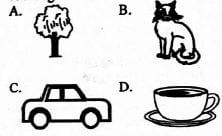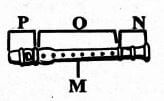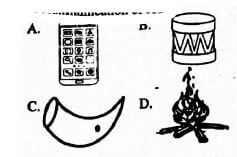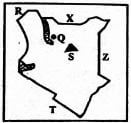QUESTIONS
ART/CRAFT.
- Machogu brought a puppet like the one drawn below to class.

This type of puppet is called a- glove puppet.
- marionette.
- rod puppet.
- hand puppet.
- Pinch technique can be applied in
- clay items.
- paper work.
- fabric.
- wood items.
- Grade 5 learners wanted to make wax crayons. They brought the following items to class:
Musa - Paraffin.
Wambu - Beeswax.
Kanu - Metallic container.
Stephanie - Rubber bands.
Who brought an item that was not necessary?- Musa
- Wambu
- Kanu
- Stephanie
- A teacher drew a form like the one shown below

Which of the following techniques did the teacher use to show shading effect?- Cross hatching
- Smudge
- Crayon etching
- Collage
- Which one of the following indigenous Kenyan crafts is made from leather?

- Coiling is a technique associated with
- leather shoes.
- fabric.
- plastic buckets.
- clay pots.
- Study the diagram below.

Which colour does letter X represent?- Violet
- Green
- Yellow
- Orange
- The diagram below shows a decorated fabric.

The technique shown above is called- tie and dye.
- batik.
- collage.
- montage.
- Which of the following shows a still life drawing?

- All the following may be needed for crayon etching except
- a drawing paper.
- a toothpick.
- plasticine.
- black ink.
MUSIC.
- Below is a wind instrument.

The wind instrument above is called- Coro.
- Orutu.
- Kayamba
- Nzumari.
- All wind instruments produce sound when
- shaken.
- hit
- bowed.
- blown
- Body movements or actions used to show the meanings of words or ideas in a song are called
- moods.
- tones.
- dictions.
- gestures.
- Below is a descant recorder.

The part labelled N is the- head joint.
- middle joint.
- end joint.
- foot joint.
- The mouth piece is found in part
- M
- N
- P
- O
- The foot joint is labelled
- P
- N
- M
- O
- All the following lines are found in the Kenya National Anthem. Which one is not?
- Kila siku tuwe na shukrani.
- Raha tupate na ustawi.
- Natulinde uhuru na amani.
- Nasi tujitoe kwa nguvu.
- Which of the following types of songs is wrongly matched with its description?
- Topical songs - sung to enlighten the community.
- Action songs - sung during a certain community activity.
- Sacred songs - sung during religious activities.
- Patriotic songs sung to show love for the country.
- Solo singing involves a performance by
- four people.
- three people.
- two people.
- one person.
- Which part of a drum is used to tune it?
- Foot
- Membrane
- Laces
- Resonator
SOCIAL STUDIES.
- All the following are not modern methods of communication except

- A motorist approached a road sign like the one shown below

What was the motorist supposed to do?- Turn back
- Call the police
- Turn off headlights
- Slow down
- All the following crops can be grown under horticulture except
- fruits.
- flowers.
- sugarcane.
- vegetables.
- Wildlife is important in our country because it
- rears animals in the country.
- attracts tourists.
- makes learners pass school tests.
- brings visitors to our homes.
- Which of the following fuels can be used in a hurricane lamp?
- Charcoal
- Sawdust
- Firewood
- Paraffin
- All the following are resources found in Kenya except
- museums.
- lakes.
- minerals.
- forests.
- Below is a method of inland fishing in Kenya.

The fishing method shown above is called- long lining.
- purse seining.
- trawling.
- harpooning.
- Study the diagram below

The activity above can be made possible in- forests.
- water bodies.
- mountains.
- valleys.
- All the following are aspects of our traditional culture. Which one is not?
- The foods we eat.
- Our religions.
- The way we build our houses.
- The curriculum we observe in school.
- Traditional artefacts are always kept in
- homes.
- museums.
- markets.
- classrooms.
- Honesty, integrity, trust and respect are examples of school
- core values.
- routine.
- mission.
- motto.
Use the map of Kenya given below to answer questions 32 to 35.

- Which letter represents Ethiopia?
- T
- Z
- X
- R
- The National Park marked Q is called
- Sibiloi.
- Amboseli.
- Maasai Mara.
- Serengeti.
- The country marked R is called
- Uganda
- Sudan
- Ethiopia
- South Sudan
- The mountain marked S is called mount
- Suswa.
- Kenya.
- Marsabit.
- Elgon.
CHRISTIAN RELIGIOUS EDUCATION
- The birth of Jesus was announced by angel
- Micah.
- Gabriel.
- Michael.
- Isaiah.
- The Lord is with you and has greatly blessed you. You will become pregnant and you will give birth to a son. Who was told these words?
- Jesus.
- Joseph
- Mary
- Angel
- Who went around river Jordan mainly preaching to the people about repentance?
- Jesus
- Elisha
- John
- Elijah
- Why is baptism important in the life of a Christian? It
- makes Christians acquire new names.
- makes a Christian a member of God's family.
- makes Christians known by other members of the church.
- is a way of bonding with church elders.
- When Jesus calmed the storm,
- His power over nature was revealed.
- the disciples were in deep sleep.
- His clothes turned crystal white.
- angels appeared to Him.
- Stories that Jesus used to teach people are called
- phrases.
- parables.
- proverbs.
- narrations.
- Why did Zacchaeus climb a sycamore tree?
- He was a sinner.
- He wanted to see Jesus.
- Jesus was passing by.
- The place was overcrowded.
- The second book in the Old Testament is called
- Mark.
- Chronicles.
- Numbers.
- Exodus.
- If your friend insults you, you should
- run away.
- insult him.
- forgive him.
- slap him.
- Which of the following is not a good practice for a Christian?
- Respecting one another.
- Helping the old.
- Abusing others.
- Going to church.
- According to Jesus' teachings during the sermon on the mountain, happy are the pure in heart because
- they will see God.
- God will call them His children.
- God will be merciful to them.
- God will reward them.
- During the baptism of Jesus, all the following took place except
- heaven opened.
- the Holy Spirit came down in form of a dove.
- a voice came from heaven.
- darkness covered the whole place.
- Jesus showed compassion to the needy when He
- performed miracles wherever He went.
- fed a crowd.
- died on the cross.
- promised them the Holy Spirit.
- John the Baptist's mother was called
- Annah.
- Rebecca.
- Elizabeth.
- Mary.
- A person who always tells the truth is said to be
- honest.
- obedient.
- polite.
- kind.
ISLAMIC RELIGIOUS EDUCATION
- How many ayats are there in surah Al- Kauthar?
- 6
- 4
- 3
- 5
- Tarmechim bibijarati minsijjeelin is a supplication from surah
- Fiyl.
- Maun.
- Kafirun.
- Lahab.
- Which of the following is not a lesson from surah Al-Qureish?
- Never take the blessings of Allah for granted
- Allah sends blessings and bounties.
- Allah blessed the Qureish with security.
- Never underestimate Allah.
- Which of the following attributes of Allah means all forgiving?
- Al-Haafidh.
- Al-Ghafar.
- Al-Aalim.
- Al-Malik.
- Which one of the following is not a characteristic of angels? Angels
- can change form.
- were created from nur.
- can either be males or females.
- do not have parents.
- The last swalah of the day is called
- Ast.
- Isha.
- Dhuhr
- Fajr.
- Saum can be described as
- a pillar of religion.
- pilgrimage.
- kindness.
- an act of devotion.
- Hajj is performed in the month of
- Muharram.
- Rajab.
- Dhulhijja.
- Ramadhan.
- The angel of Allah who brings rain is called
- Jibril
- Malik.
- Mikail.
- Israfil
- When you recite dua for leaving and entering the house,
- your faith in religion becomes stronger.
- you become lucky.
- angels surround you.
- Allah protects you.
- Which of the following is not an optional prayer?
- Fajr
- Qabliyah
- Taraweh
- Baadiyah
- Which of the following is not a condition for swalah? One has to
- be in ritual purity.
- wear new clothes.
- be a Muslim.
- have sound mind.
- When we perform swalah correctly, we earn
- points.
- gifts.
- curses.
- thawabs.
- Which of the following is the last step in swalah?
- Maintaining a bowing posture.
- Turning the head to the left.
- Standing straight upright.
- Turning the head to the right.
- As a Muslim child, it is the obligation of my parents to
- obey me.
- cater for my basic needs.
- buy me computer games.
- do my homework for me.
MARKING SCHEME

Join our whatsapp group for latest updates
Tap Here to Download for 30/-
Get on WhatsApp for 30/-
Download Creative ARTS & Social Studies/RE Questions and Answers - Grade 5 Mid Term 2 Exam 2023 Set 1.
Tap Here to Download for 30/-
Get on WhatsApp for 30/-
Why download?
- ✔ To read offline at any time.
- ✔ To Print at your convenience
- ✔ Share Easily with Friends / Students

